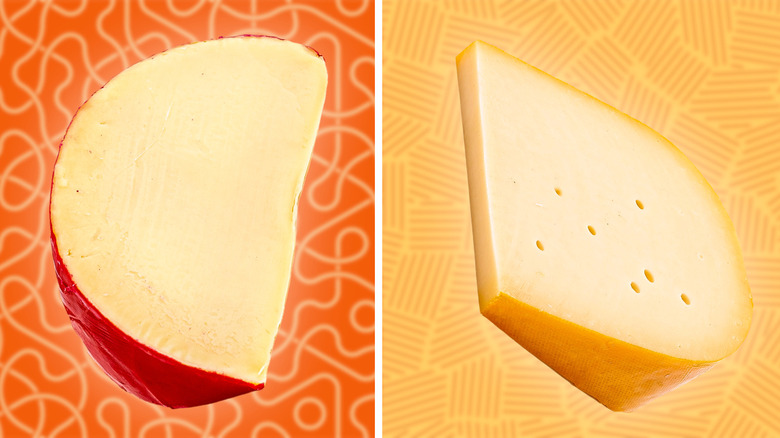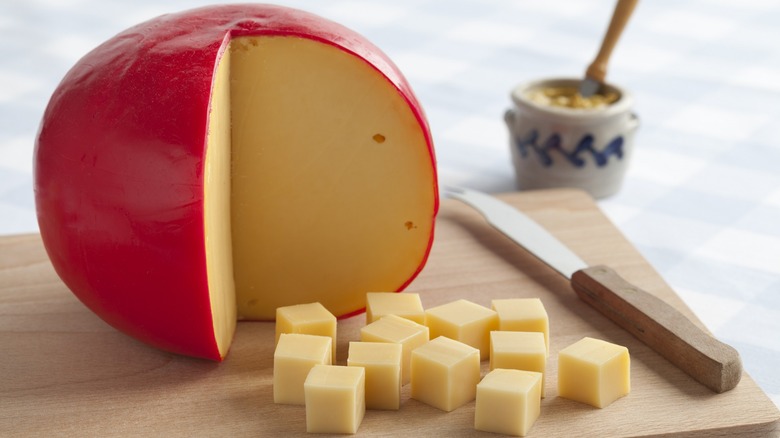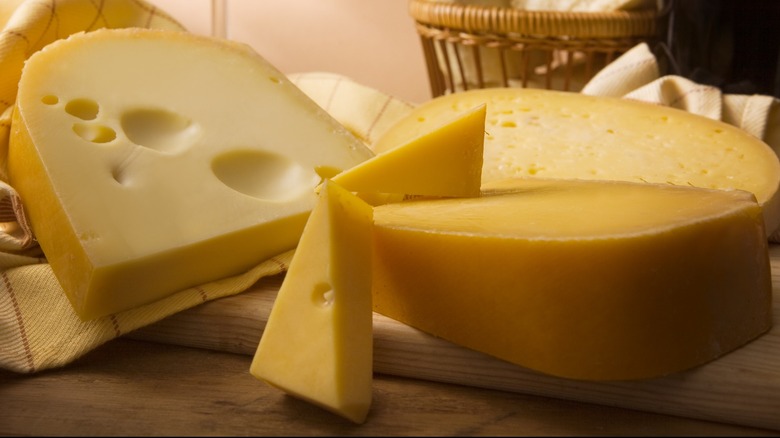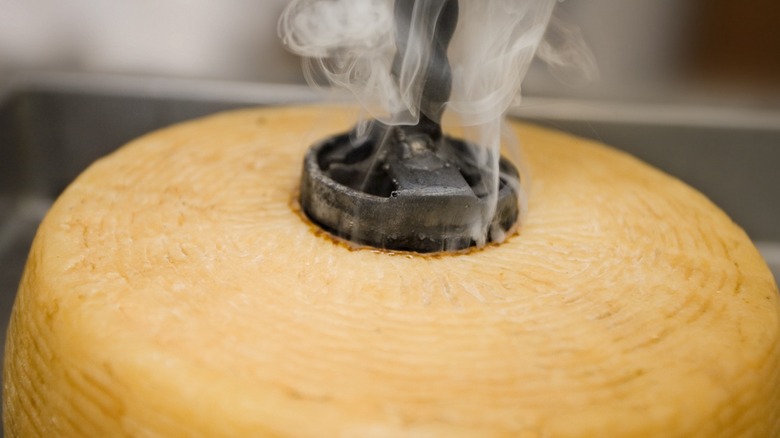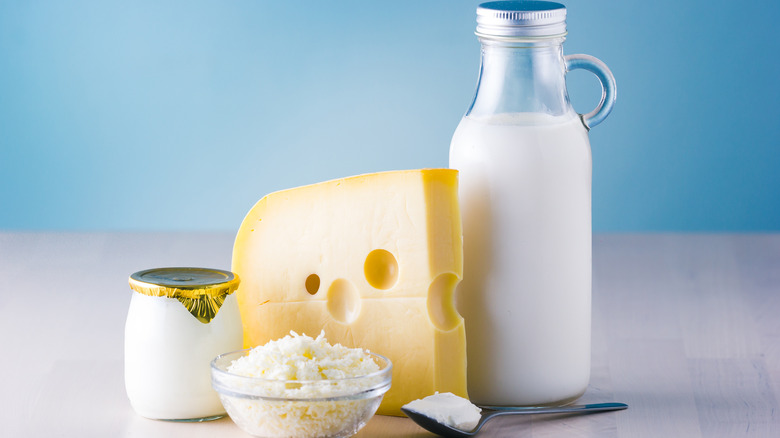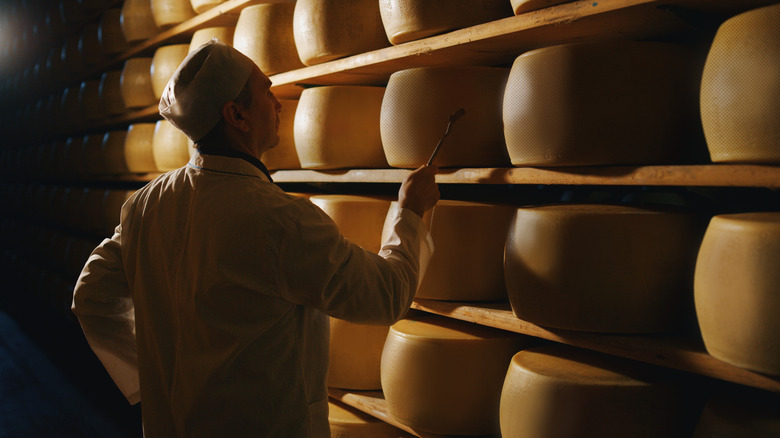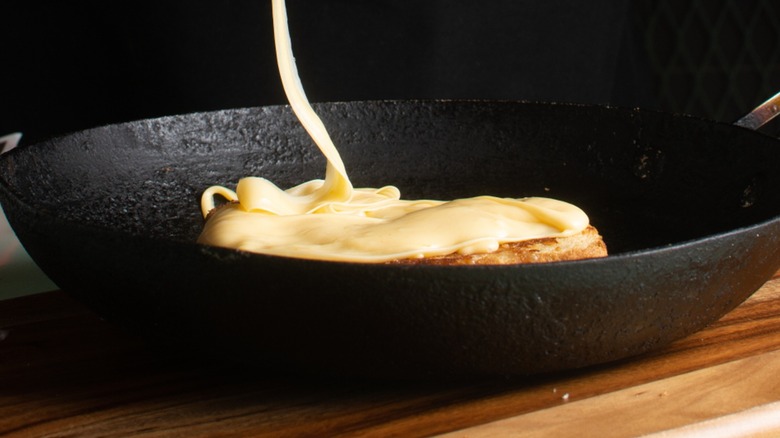What's The Difference Between Edam And Gouda Cheese?
Prepping your next festive charcuterie board can be a daunting task, what with so many different (and delicious) types of cheese to choose from. Whether plating sharp cheddar cubes, fresh mozzarella balls, or flavored goat cheese logs, it's important to understand the unique qualities of and differences between cheese varieties — especially the ones that seem similar. Both originating in Amsterdam, Edam and Gouda share many similarities.
Both Dutch cheeses are pale yellow, made from cow's milk, and work well as a melted component in sauces and soups. Cheesemakers produce both Edam and Gouda in the traditionally Dutch "washed curd" method, which involves removing the whey and adding warm water. This process reduces the lactose content of the cheese, resulting in the slower lactic acid development that yields a sweeter, milder cheese.
But despite their resemblance, these cheeses boast distinct characteristics. Edam is drier and tarter than Gouda, browns better, and is more well-suited for slicing. Gouda, on the other hand, is creamier than Edam, contains more fat, and offers a smoother melt. So, what makes these cheese twins stand apart? Let's cut away the rind and take a look inside the cheese wheels.
What is Edam?
Born in North Amsterdam, Edam is named for its region of origin. Though the English pronunciation of Edam typically sounds like "e-dam," the original Dutch pronunciation is closer to "a-dahm." This cheese has a firm texture and a slightly nutty, salty taste. The wheels are often encased in a red wax seal to prevent the cheese from molding and losing its moisture content. This signature red wax gives Edam a recognizable pop of color in grocery stores and artisan markets.
When you think of mature cheese, you probably picture cheddar, Parmesan, and Gouda, but Edam is also available in aged varieties. Though the aging process is generally a few months shorter than its Dutch counterpart, Gouda, aged Edam still has a more intense flavor and a harder texture than young Edam. If you prefer milder cheese, opt for young Edam, and if you're a fan of bolder flavors, try it in an aged variety.
What is Gouda?
Also originating in the town of its namesake, Gouda comes from a region southwest of Amsterdam. While Americans pronounce the cheese "goo-duh," the authentic pronunciation is closer to "how-duh," with a harsher, more emphasized "H" sound. Gouda's higher fat content makes it creamier than Edam, and this cheese is aged more often than the latter type as well. Most grocery stores, however, offer younger, smoother varieties of Gouda.
And if you've ever perused the cheese aisle at the grocery store, you'll know that sweet and mild Gouda is often famously enhanced with additional flavors, like smoke infusions or herb and spice rubs. Perhaps the variety of experimental flavors is what makes Gouda such a popular cheese. The most successful of all Dutch cheeses, Gouda dominates the dairy market in popularity and variety. Gouda even has its own festive cheese market, held in the city of Gouda between April and September.
Edam is salty and Gouda offers options
Though similar in their mild, somewhat sweet flavors, Edam and Gouda have subtle taste differences that set them apart. Edam tastes a bit tart with hints of sweet nuttiness and a salty undertone, whereas Gouda has more prominent sweet and nutty flavors. Both cheeses undergo flavor changes with time, as the aging process amplifies their distinctive tastes.
That may seem like a wide-ranging flavor profile, but a lot of the flavor comes from the quality of cow's milk used to make the cheese, as well as the diets of the cows. The salty flavor of Edam may also come from its salt brine. Although Gouda is also brined in the cheese-making process, Edam's lower fat percentage allows the salty flavor to come through more than Gouda.
Edam can be accentuated with additional flavors, but Gouda certainly boasts a larger repertoire, including smoked, spiced, and infused varieties that pack an even more flavorful punch. Mingling savory smokiness with the delicate sweetness of Gouda is one of the most common flavor elevations, from apple-smoked Gouda to hickory-smoked bourbon Gouda.
Edam is drier and Gouda is creamier
Edam, while similar to Gouda, has a drier texture that works well for slicing. If you've ever tried slicing Gouda, even with a cheese knife, you'll understand that it can be hard to get a clean cut. While Gouda is made with whole milk, Edam starts with partially skimmed milk, meaning that it has a lower fat content. The reduced milk fat percentage means that Edam holds less moisture than full-fat Gouda, contributing to its drier texture.
Skimming milk is the process of removing the higher fat contents of cream from the milk. Historically, dairy farmers would let raw milk settle, and the thicker cream would rise, allowing them to literally skim it off the top. Now, skimming usually happens within a centrifugal separator, resulting in lower-fat milk. Because Edam contains partially skimmed milk, it has a lower fat content (40%) than Gouda, which is 48% fat. Gouda's higher fat percentage and better ability to hold moisture are what give it that extra creamy factor.
Aged Edam is flakier and aged Gouda is crumblier
Speaking for both Edam and Gouda, the aging process creates more concentrated flavors as moisture is lost and microbes and enzymes continue working inside the wheel of cheese. The bacteria introduced in the cheese-making process turn the lactose from cow's milk into lactic acid, but since "washed curd" cheeses are lighter on lactose, they develop a sweet flavor as opposed to the sharp, tangy notes of aged cheddar.
Aged Gouda has a crumbly texture, verging on more nuttiness, with sweeter caramel and butterscotch undertones, while aged Edam has a flaky texture and a sharper tartness. Gouda becomes distinctive in its age because it's more likely to develop cheese crystals.
Cheese crystals are composed of the amino acid tyrosine, which forms little white clusters as the cheese proteins break down during the aging process. The maturation of cheese and formation of cheese crystals make aged Gouda more crumbly and give the cheese a surprisingly crunchy bite.
Slice Edam, sprinkle Gouda, and melt both
Many people enjoy snacking on both Edam and Gouda, because their naturally mild, nutty, and sweet flavors are appealing to picky eaters and cheese connoisseurs alike. Either cheese would be a worthy inclusion on a charcuterie board, pairing well with fresh fruit, dried fruit, and jam.
Young Gouda is most suitable for melting into creamy sauces and cheesy soups because it still retains a sufficient moisture content for maximum meltiness. The full-fat milk used in its creation comes in handy for super creamy macaroni and cheese, melty grilled cheese, and ultra-smooth fondue. Aged Gouda works wonderfully as a crumbly topping to give a slight textural change and notes of complex sweetness to a dish.
Edam is an excellent choice for slicing up and piling onto a sandwich, bringing a mild flavor profile that can complement many different sandwich combinations. Also a contender for melting, try grating Edam into Puerto Rican cornmeal fritters or Macanese meatloaf for melty accents to your meal. No matter which cheese you choose, both are sure to leave you wanting more!
